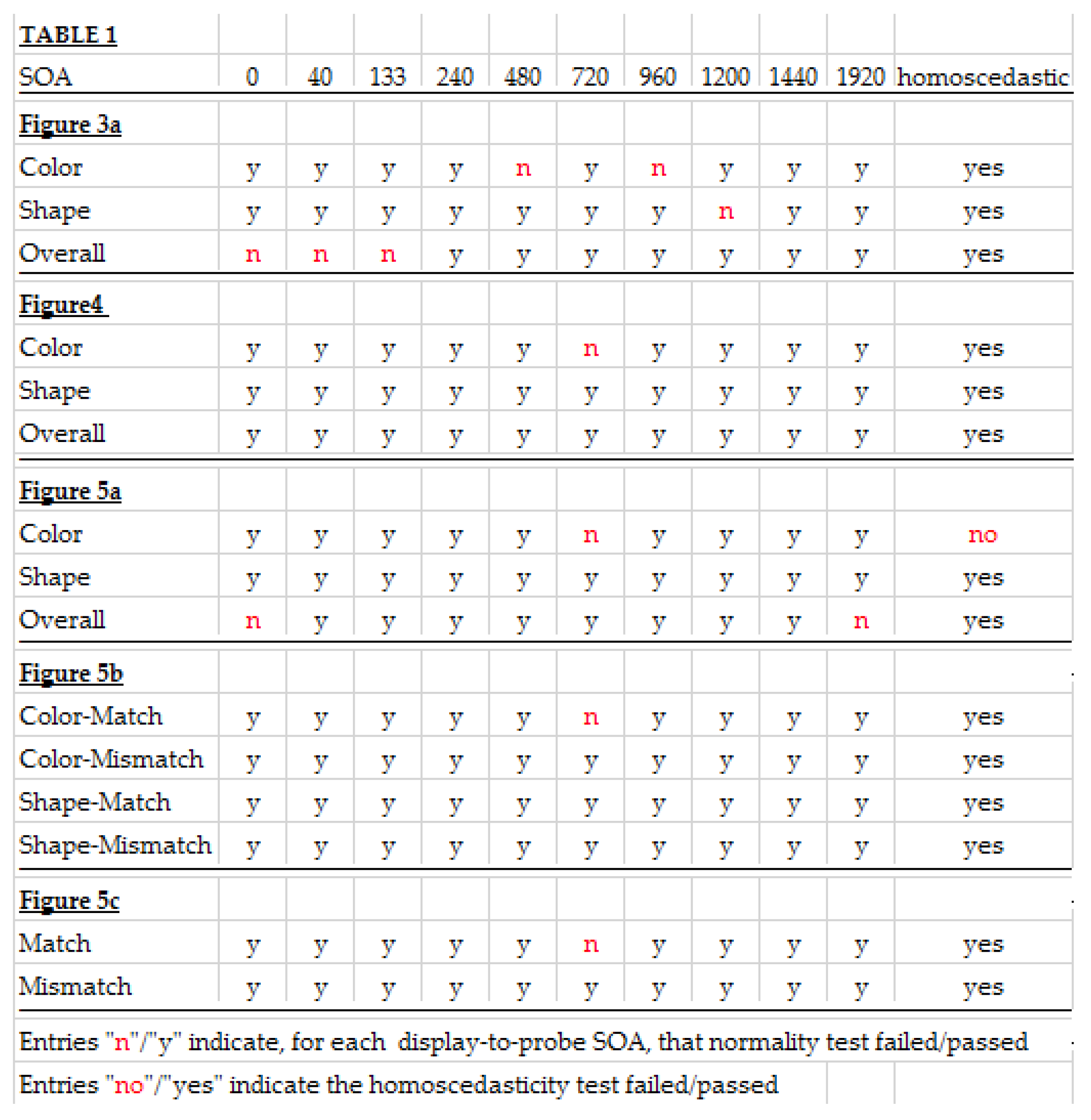Visual Memory Scan Slopes: Their Changes over the First Two Seconds of Processing
Abstract
:1. Introduction
1.1. Elaborations of the Temporal Properties of VSTM
1.2. Significance of Expected Findings
2. Materials and Methods
2.1. Participants
2.2. Apparatus
2.3. Stimuli and Procedure
2.4. Statistical Methods
3. Results and Discussion
3.1. Tests of Normality and Homoscedasticity
3.2. Analysis of VSTM Storage Values
3.3. Analysis of VSTM Storage-Slopes
3.4. Analysis of VSTM Scan-Slopes
3.5. Relations between VSTM Storages, Storage-Slopes, and Scan-Slopes
4. General Discussion
4.1. Relation of Present Findings to Those of Prior Studies
4.2. A Bigger Picture: The Nonmonotonic, Nonlinear Function Relating WSTM Scan-Slopes to SOA
4.3. Ecological, Real-Life Relevance of Our Findings
Author Contributions
Funding
Institutional Review Board Statement
Informed Consent Statement
Data Availability Statement
Acknowledgments
Conflicts of Interest
Appendix A
References
- Atkinson, R.C.; Shiffrin, R.M. Human memory: A proposed system and its control processes. In The Psychology of Learning and Motivation: Advances in Research and Theory; Spence, K.W., Spence, J.T., Eds.; Academic Press: New York, NY, USA, 1968; Volume 2, pp. 89–195. [Google Scholar]
- Di Lollo, V. Temporal characteristics of iconic memory. Nature 1977, 267, 241–243. [Google Scholar] [CrossRef] [PubMed]
- Coltheart, M. Iconic memory and visible persistence. Percept. Psychophys. 1980, 27, 183–228. [Google Scholar] [CrossRef] [Green Version]
- Sperling, G. The information available in a brief visual presentation. Psychol. Monogr. 1960, 74, 1–29. [Google Scholar] [CrossRef]
- Dixon, P.; Di Lollo, V. Effects of display luminance, stimulus type, and probe duration on visible and schematic persistence. Canad. J. Psychol. 1991, 45, 54–74. [Google Scholar] [CrossRef]
- Irwin, D.E.; Yeomans, J.M. Sensory registration and informational persistence. J. Exp. Psychol. Hum. Percept. Perform. 1986, 12, 343–360. [Google Scholar] [CrossRef]
- Cowan, N. The magical mystery four: How is working memory capacity limited, and why? Cur. Dir. Psychol. Sci. 2010, 19, 51–57. [Google Scholar] [CrossRef] [Green Version]
- Sperling, G. A model for visual memory tasks. Hum. Fact. 1963, 5, 19–31. [Google Scholar] [CrossRef] [PubMed]
- Sternberg, S. High-speed scanning in human memory. Science 1966, 153, 652–654. [Google Scholar] [CrossRef] [PubMed] [Green Version]
- Sternberg, S. Memory-scanning: Mental processes revealed by reaction time experiments. Amer. Scient. 1969, 57, 421–457. [Google Scholar]
- Vogel, E.K.; Woodman, G.F.; Luck, S.J. The time course of consolidation in visual working memory. J. Exp. Psychol. Hum. Percept. Perform. 2006, 32, 1436–1451. [Google Scholar] [CrossRef]
- Woodman, G.F.; Vogel, E.K. Fractionating working memory: Encoding and maintenance are independent processes. Psychol. Sci. 2005, 16, 106–113. [Google Scholar] [CrossRef] [PubMed]
- Woodman, G.F.; Vogel, E.K. Selective storage and maintenance of an object’s features in visual working memory. Psychon. Bull. Rev. 2008, 15, 223–229. [Google Scholar] [CrossRef] [Green Version]
- Jacob, J.; Breitmeyer, B.G.; Treviño, M. Tracking the first two seconds: Three stages of visual information processing? Psychon. Bull. Rev. 2013, 20, 1114–1119. [Google Scholar] [CrossRef] [Green Version]
- Treisman, A.; Gormican, S. Feature analysis in early vision: Evidence from search asymmetries. Psychol. Rev. 1988, 95, 15–48. [Google Scholar] [CrossRef]
- Wolfe, J.M. Guided Search 2.0: A revised model of visual search. Psychon. Bull. Rev. 1994, 1, 202–238. [Google Scholar] [CrossRef] [PubMed] [Green Version]
- Wyble, B.; Potter, M.C.; Bowman, H.; Nieuwenstein, M. Attentional episodes in visual perception. J. Exp. Psychol. Gen. 2011, 140, 488–505. [Google Scholar] [CrossRef]
- Duncan, J.; Ward, R.; Shapiro, K. Direct measurement of attentional dwell time in human vision. Nature 1994, 369, 313–315. [Google Scholar] [CrossRef] [PubMed]
- Ward, R.; Duncan, J.; Shapiro, K. The slow time-course of visual attention. Cogn. Psychol. 1996, 30, 79–109. [Google Scholar] [CrossRef] [PubMed]
- Alvarez, G.A.; Cavanagh, P. The capacity of visual short-term memory is set both by visual information load and by number of objects. Psychol. Sci. 2004, 15, 106–111. [Google Scholar] [CrossRef]
- Awh, E.; Barton, B.; Vogel, E.K. Visual working memory represents a fixed number of items regardless of complexity. Psychol. Sci. 2007, 18, 622. [Google Scholar] [CrossRef] [PubMed]
- Eng, H.Y.; Chen, D.; Jiang, Y. Visual working memory for simple and complex visual stimuli. Psychon. Bull. Rev. 2005, 12, 1127–1133. [Google Scholar] [CrossRef] [Green Version]
- Wheeler, M.E.; Treisman, A.M. Binding in short-term visual memory. J. Exp. Psychol. Gen. 2002, 131, 48–64. [Google Scholar] [CrossRef]
- Cowan, N.; Blume, C.L.; Saults, J.S. Attention to attributes and objects in working memory. J. Exp. Psychol. Learn. Mem. Cogn. 2013, 39, 731–747. [Google Scholar] [CrossRef] [PubMed] [Green Version]
- Sperling, G.; Budiansky, J.; Spivak, J.G.; Johnson, M.C. Extremely rapid visual search: The maximum rate of scanning letters for the presence of a numeral. Science 1971, 174, 307–311. [Google Scholar] [CrossRef]
- Raymond, J.E.; Shapiro, K.L.; Arnell, K.M. Temporary suppression of visual processing in an RSVP task: An attentional blink? J. Exp. Psychol. Hum. Percept. Perform. 1992, 18, 849–860. [Google Scholar] [CrossRef]
- Shapiro, K.L.; Raymond, J.E.; Arnell, K.M. Attention to visual pattern information produces the attentional blink in RSVP. J. Exp. Psychol. Hum. Percept. Perform. 1994, 20, 357–371. [Google Scholar] [CrossRef]
- Craston, P.; Wyble, B.; Chennu, S.; Bowman, H. The attentional blink reveals serial working memory encoding: Evidence from virtual and human event-related potentials. J. Cogn. Neurosci. 2009, 21, 550–566. [Google Scholar] [CrossRef] [PubMed] [Green Version]
- Nieuwenstein, M.R.; Chun, M.M.; van der Lubbe, R.H.J.; Hooge, I.T.C. Delayed attentional engagement in the attentional blink. J. Exp. Psychol. Hum. Percept. Perform 2005, 31, 1463–1475. [Google Scholar] [CrossRef] [Green Version]
- Vogel, E.K.; Luck, S.J. Delayed working memory consolidation during the attentional blink. Psychon. Bull. Rev. 2002, 9, 739–743. [Google Scholar] [CrossRef] [Green Version]
- Vul, E.; Nieuwenstein, M.; Kanwisher, N. Temporal selection is suppressed, delayed, and diffused during the attentional blink. Psychol. Sci. 2008, 19, 55–61. [Google Scholar] [CrossRef]
- Martínez-García, M.; Zhang, Y.; Gordon, T. Memory pattern identification for feedback tracking control in human–machine systems. Hum. Fact. 2021, 63, 210–226. [Google Scholar] [CrossRef] [PubMed] [Green Version]
- Martínez-García, M.; Gordon, T.; Shu, L. Extended crossover model for human-control of fractional order plants. IEEE Access 2017, 5, 27622–27635. [Google Scholar] [CrossRef]
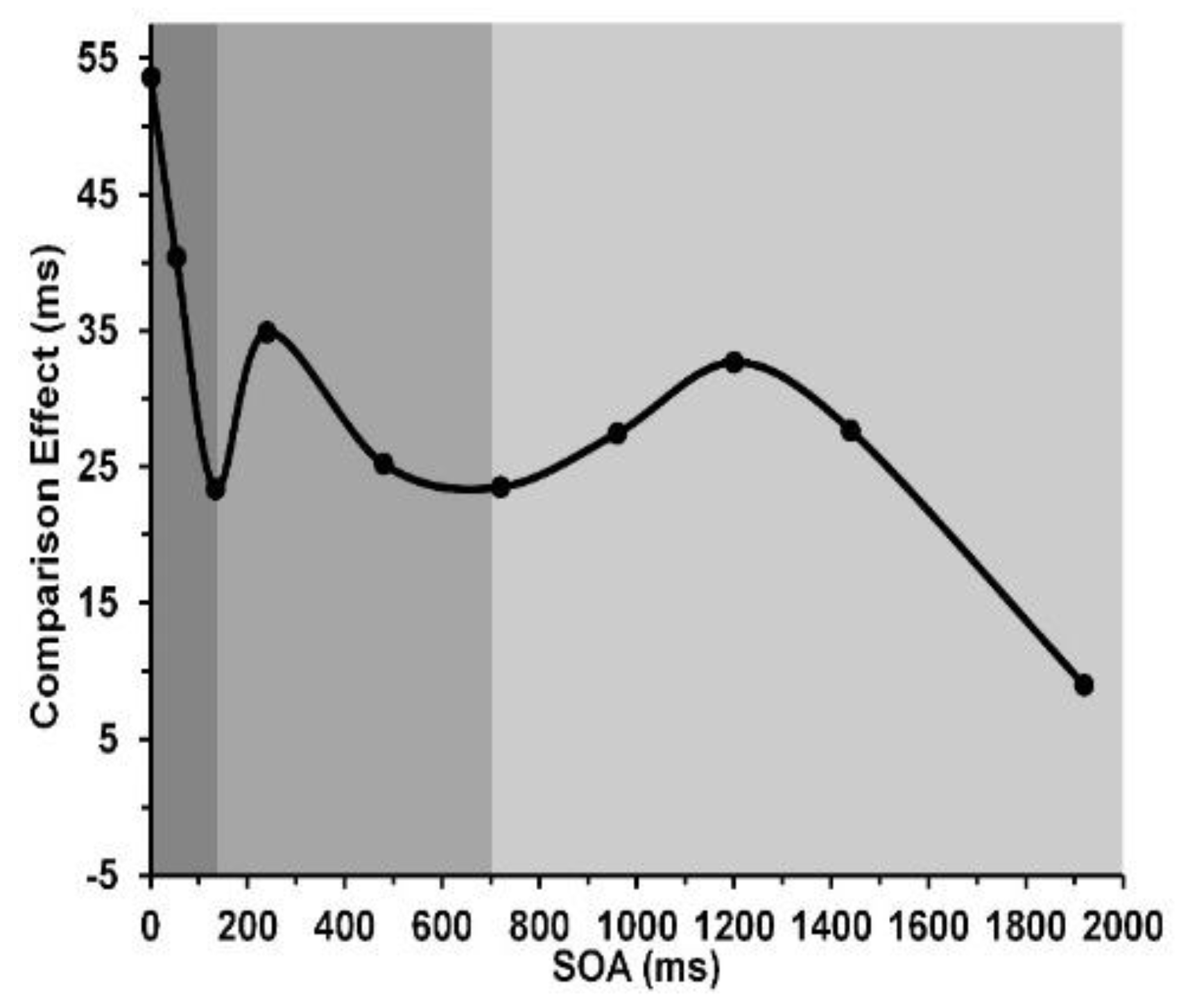
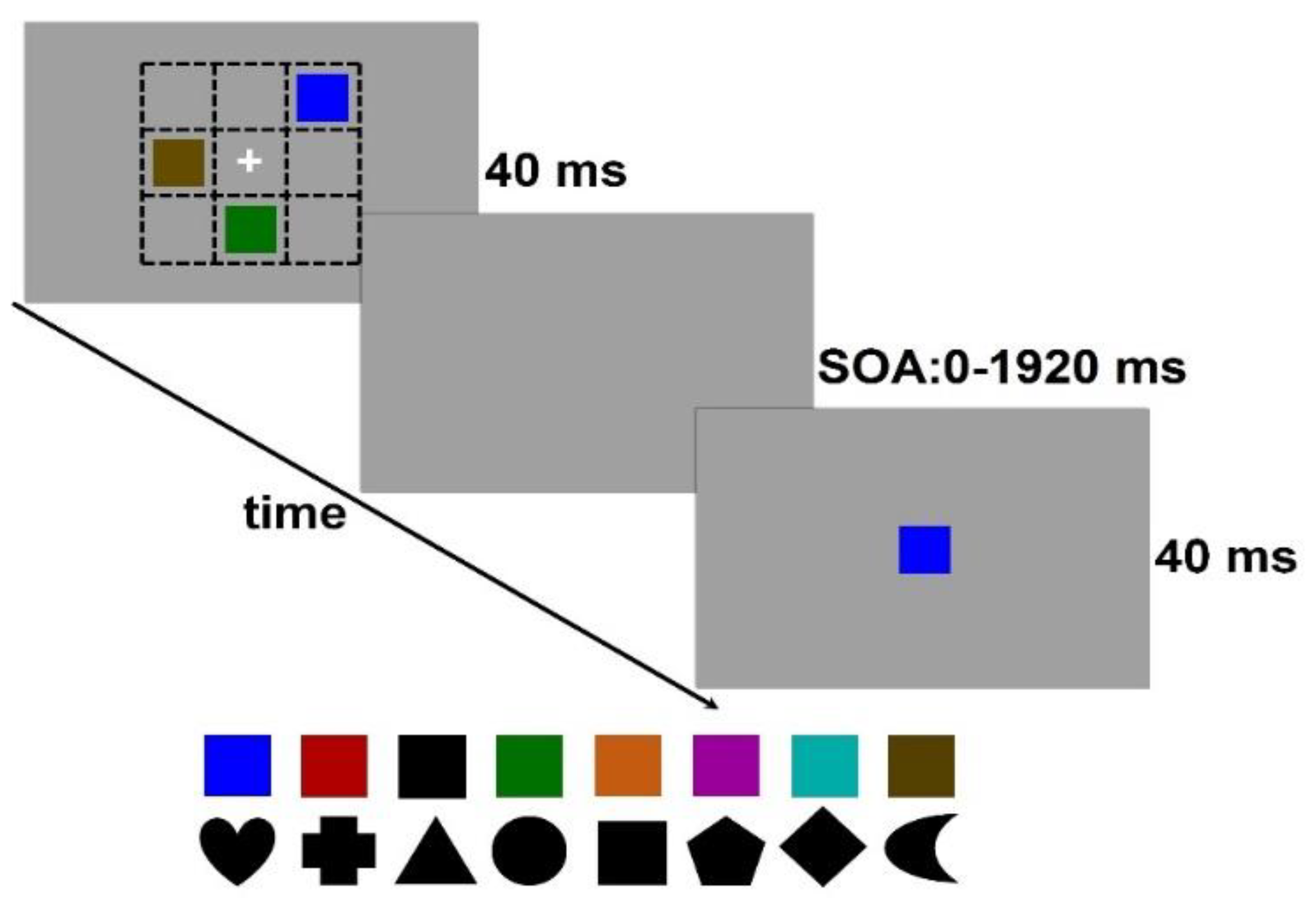
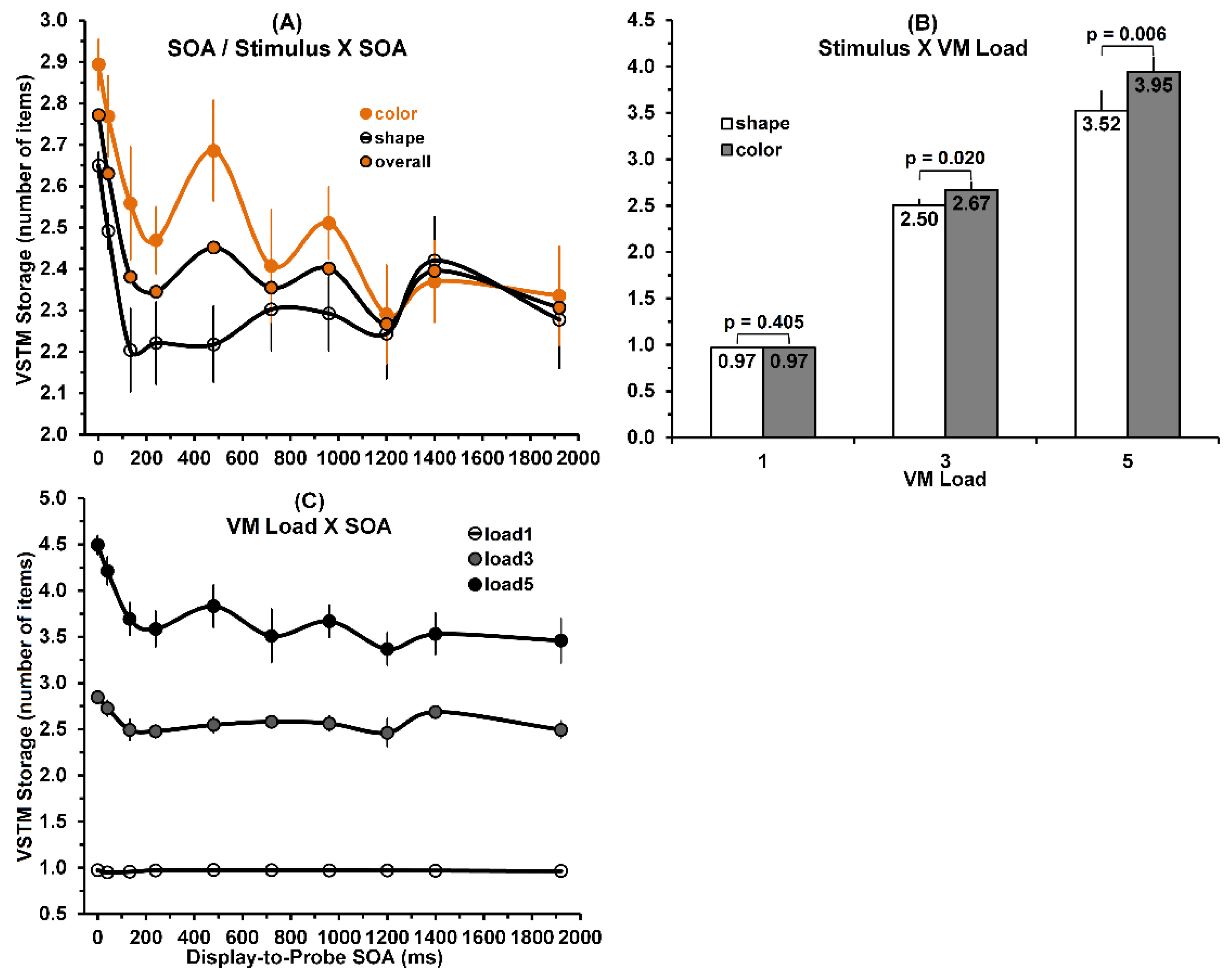
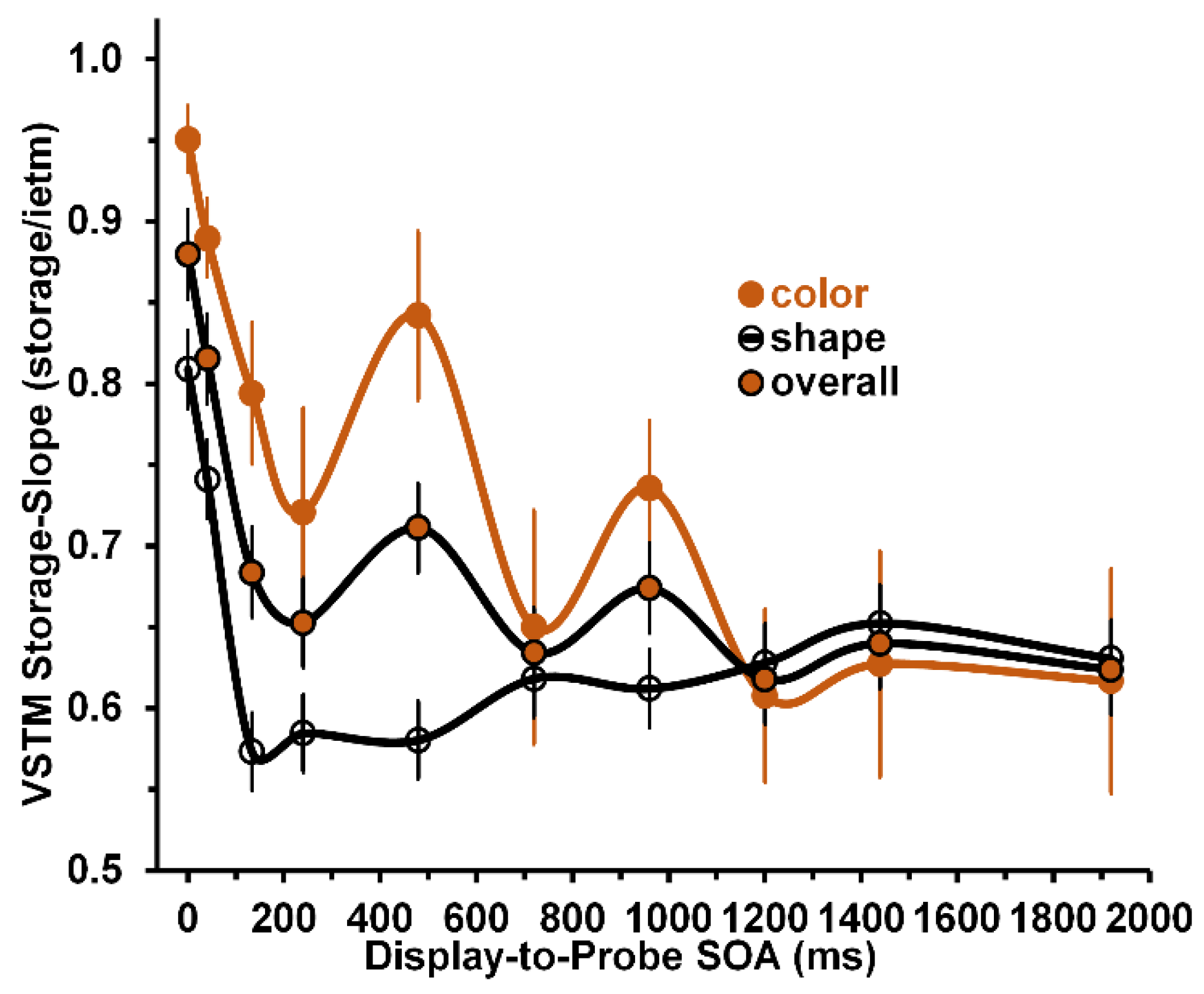
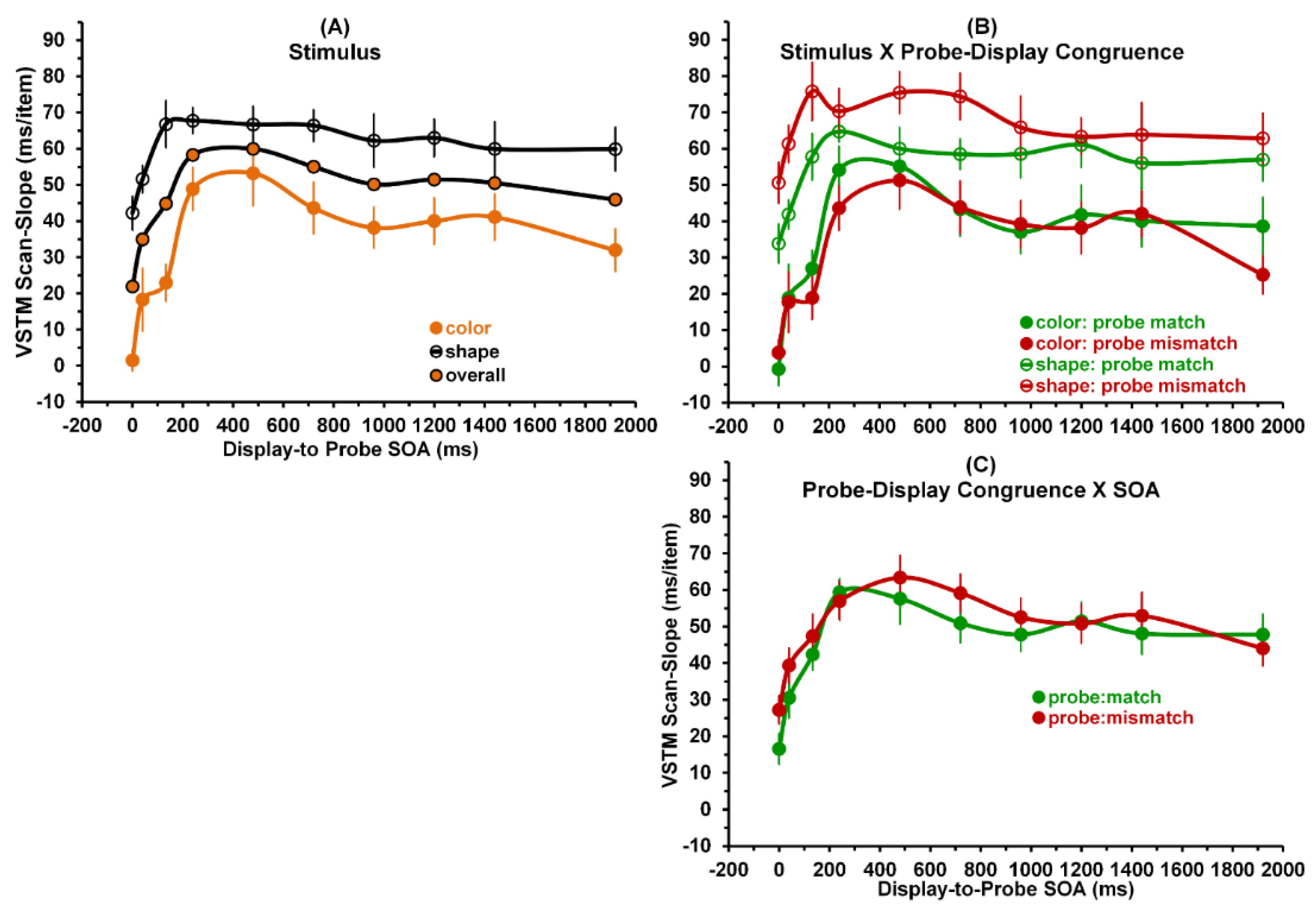
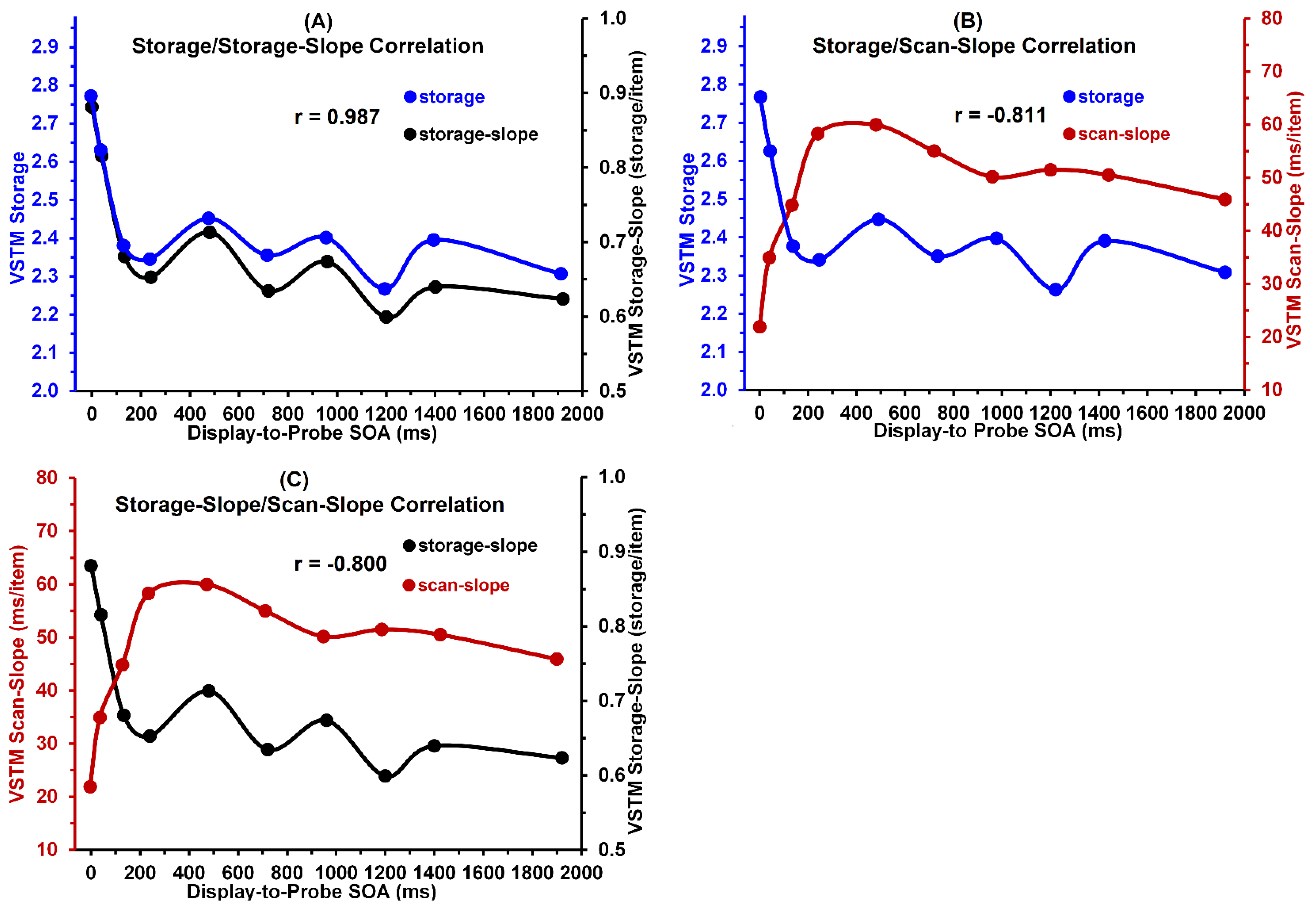
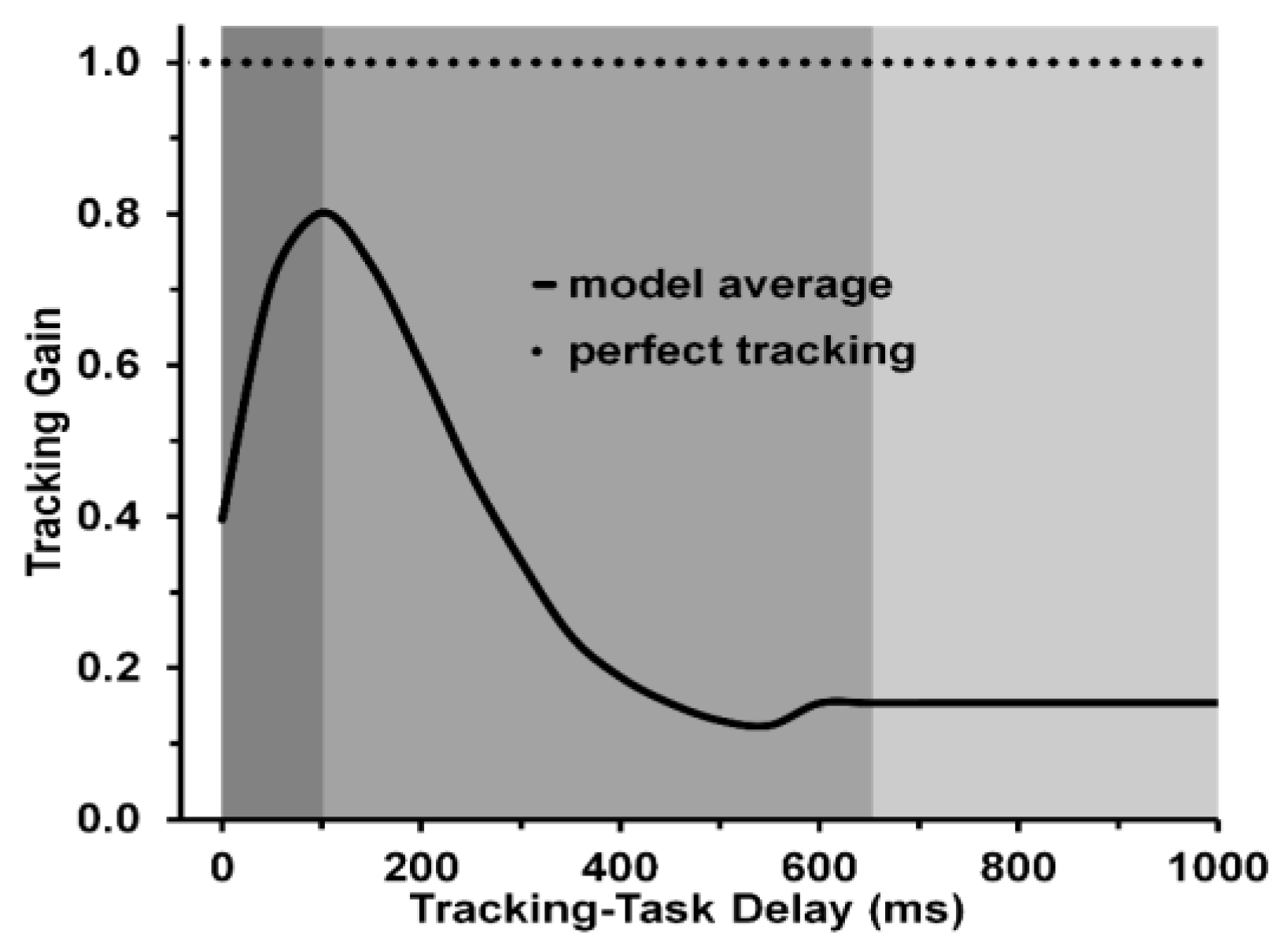
Publisher’s Note: MDPI stays neutral with regard to jurisdictional claims in published maps and institutional affiliations. |
© 2021 by the authors. Licensee MDPI, Basel, Switzerland. This article is an open access article distributed under the terms and conditions of the Creative Commons Attribution (CC BY) license (https://creativecommons.org/licenses/by/4.0/).
Share and Cite
Jacob, J.; Breitmeyer, B.G.; Treviño, M. Visual Memory Scan Slopes: Their Changes over the First Two Seconds of Processing. Vision 2021, 5, 53. https://doi.org/10.3390/vision5040053
Jacob J, Breitmeyer BG, Treviño M. Visual Memory Scan Slopes: Their Changes over the First Two Seconds of Processing. Vision. 2021; 5(4):53. https://doi.org/10.3390/vision5040053
Chicago/Turabian StyleJacob, Jane, Bruno G. Breitmeyer, and Melissa Treviño. 2021. "Visual Memory Scan Slopes: Their Changes over the First Two Seconds of Processing" Vision 5, no. 4: 53. https://doi.org/10.3390/vision5040053
APA StyleJacob, J., Breitmeyer, B. G., & Treviño, M. (2021). Visual Memory Scan Slopes: Their Changes over the First Two Seconds of Processing. Vision, 5(4), 53. https://doi.org/10.3390/vision5040053






